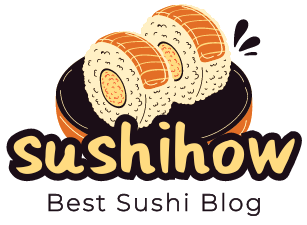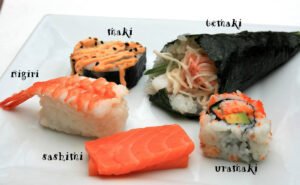Nigiri sushi features a small mound of vinegared rice topped with slices of fish – considered the purest form of sushi and handcrafted by each chef, creating works of art!
Tuna, hamachi and unagi are among the more commonly available types of nigiri sushi; however there are numerous others! Learn more about them as well as any others available below!
1. Tuna Nigiri
Tuna Nigiri Sushi is a delicious bite-sized mound of rice topped with slices of raw fish, typically decorated with wasabi paste and strips of nori seaweed sheets for decoration.
Choose sushi-grade tuna that has been cold water wild-caught and frozen, and check for marbling (otoro) above the abdominal fins. If possible, go for rare cuts like kamatoro or nouten.
Tuna is an excellent source of omega-3 fatty acids, vitamin B12 and calcium; making it one of the top foods to reduce inflammation in the body. Be careful of add-ons that increase caloric and fat intake though.
2. Salmon Nigiri
Salmon nigiri sushi is an addictive bite-sized ball of vinegared sushi rice topped with a thin slice of raw salmon, often eaten with wasabi and soy sauce or salt and citrus zest for maximum enjoyment. Salmon sushi provides great nutritional benefits including Omega 3 fats such as EPA and DHA along with B12, selenium, iodine and protein for good measure!
Fresh, firm salmon makes the ideal sushi fish. To prepare it, place both hands in water to keep from sticking and shape a piece of rice into an oblong shape with your index and middle fingers. Add slices of salmon for garnishing before spreading some wasabi on top and topping off your creation with finely cut Peking green onion strands.
Nigiri sushi, like other varieties of nigiri sushi, is typically enjoyed with chopsticks but can also be picked up and enjoyed directly using one’s hands. When combined with pickled ginger that often accompanies sushi meals, this meal becomes truly delightful!
3. Shrimp Nigiri
Shrimp nigiri sushi is an enjoyable seafood choice for sushi fans. This tasty treat consists of an oblong mound of sushi rice with raw shrimp draped across it and gently hand shaped by hand to showcase their natural sweetness and delicate texture.
Nigiri sushi features an assortment of fish. Salmon offers its buttery texture and delicate flavor; yellowtail (hamachi) provides firm flesh that has mild sweetness; while eel offers its succulent texture and deep flavors as a filling choice.
Nigiri sushi provides carbohydrates for energy and small amounts of fiber, while also offering added sugars and sodium levels to increase consumption in moderation. Furthermore, this food offers protein as well as omega-3 fatty acid intake for better overall health.
4. Eel Nigiri
Unagi (eel) is a delicious sushi ingredient that’s often enjoyed as either nigiri or unagi don (eel bowl). With its delicate yet rich savory flavor accentuated by the sweet soy glaze it is typically basted with, unagi makes for a wonderful way to introduce people who may otherwise shy away from raw fish texture to sushi dining.
As with other sushi dishes, unagi no tare (sweet sauce for unagi) is made up of soy sauce, mirin, sugar and sake (Japanese rice wine). This combination is known for its umami qualities – one of five basic taste sensations – adding sweetness while offsetting any potential saltiness in the sushi rice.
Grilled eel is typically served on top of a mound of sushi rice and garnished with just a dash of wasabi for decoration, then cut into bite-size pieces before being eaten with fingers. A container of powdered sansho pepper often arrives to give diners another layer of flavor; its tart bite balances out the richness of the fish dish nicely.
5. Shrimp Maki
Your choice of sushi can make or break your diet, according to Ella Davar, RD, CDN. While certain ingredients can add an abundance of nutrients to your meal, others could add significant sodium and sugar levels, she recommends. She advises pairing raw fish slices (nigiri) with either salads or cooked vegetables as the perfect pairings for optimal success.
Nigiri Salmon, consisting of slices of salmon layered atop pressed rice, is another delicious but lower calorie option in sushi dining. Tempura shrimp add a crunchy texture and unique flavor that perfectly balance the salmon and rice flavors.
Hosomaki rolls are quick and easy sushi bites designed for single consumption, typically featuring cucumber, tuna or avocado filling ingredients. Hosomaki sushi may also contain smoked salmon which has higher omega-3 fats and protein than other forms of nigiri sushi.
6. Salmon Maki
Sushi rolls are a type of maki sushi composed of rice and fillings rolled tightly in sheets of seaweed called nori, then tightly sealed shut. Ingredients included tuna, salmon and eel; vegetables such as cucumbers and avocado; or even cream cheese for an American take on the classic sushi roll!
Maki sushi provides an abundance of protein, carbohydrates, fats and antioxidants such as vitamins C and K and omega-3 fatty acids that have been associated with lower risk of heart disease. Salmon, mackerel and herring are good sources of these essential fatty acids.
Maki sushi contains many nutritionally valuable ingredients such as nori (an excellent source of iodine, calcium, magnesium and iron), sesame seeds, tobiko and sliced scallions – each providing different textures and tastes to appeal to different palates.



